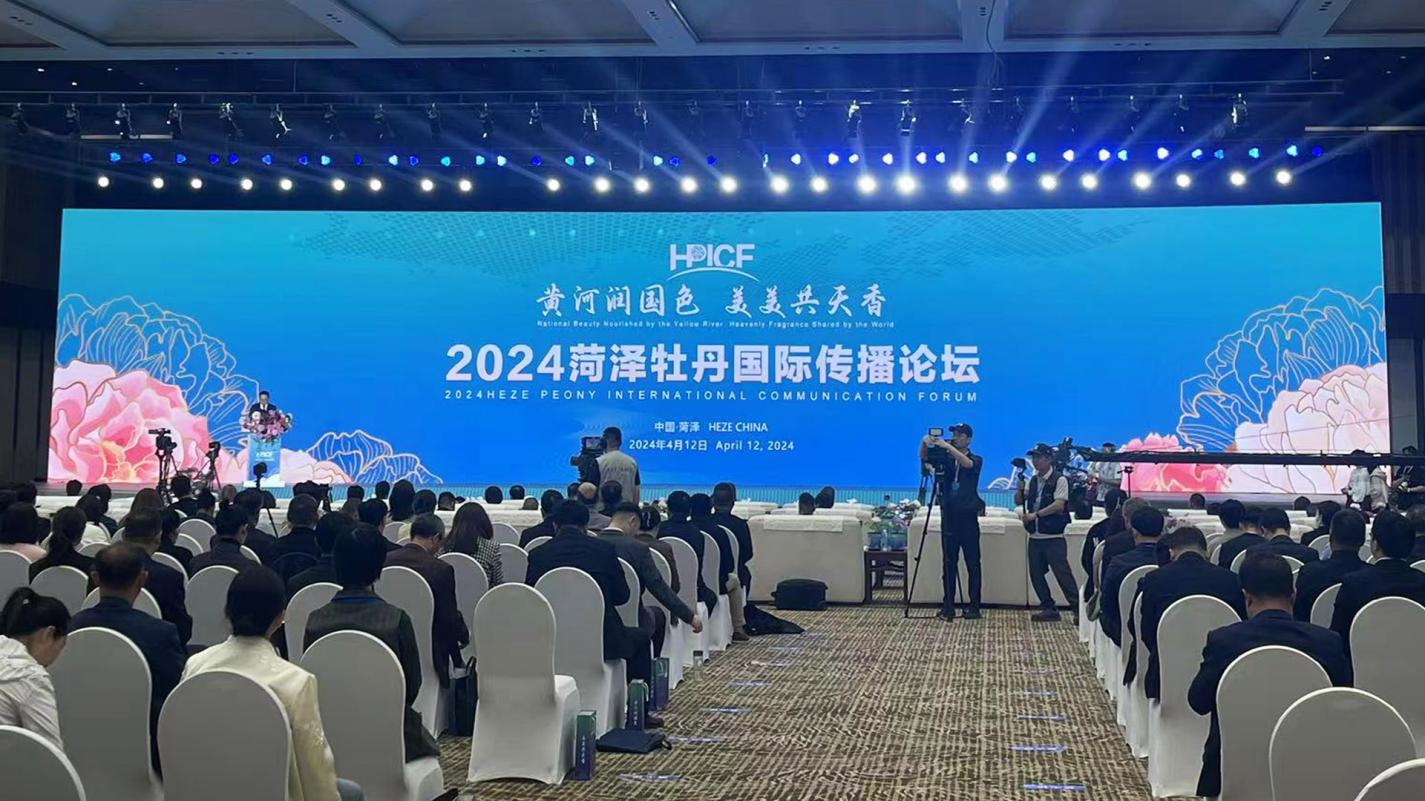Almost in his 90s, Taiwan veteran Kao Bing-han returned to his hometown in Heze City, Shandong Province, last year. Since 1991, he's dedicated himself to bringing back the ashes of deceased Chinese veterans to their birthplaces on the Chinese mainland. For his efforts, Kao was granted the 2012 "Touching China" award.
When he returned home, Kao was astounded by the development of Heze's peony industry. "I'm overwhelmed by these peony products. There are flowers, seed oil and even cosmetics made from peonies. This is definitely a promising industry. It deserves to be promoted and flourish," said Kao.
Dating back more than 1,500 years, the cultivation of peony flowers has long nurtured the peony culture and industry in the Heze area. As the time is ripe, the 2024 Heze Peony International Communication Forum (HPICF) opens on Friday.

Peonies in full bloom in Heze City, Shandong Province, east China. /CGTN
Nourished by the Yellow River
The city of Heze is renowned as the "hometown of peonies." Heze boasts the largest peony cultivation and research center in the world. As of 2023, the city was home to a collection of more than 1,300 varieties of the species. Having been exported globally since the 1950s, Heze's peonies now account for more than 70 percent of the global peony seed and seedling trade.
With the theme "National beauty nourished by the Yellow River, heavenly fragrance shared by the world," the 2024 HPICF is jointly organized by the Publicity Department of the CPC Heze Municipal Committee and the Center for International Cultural Communication of China International Communications Group.
The forum is attended by over 300 guests from a dozen countries and regions. A series of immersive, peony-related activities are offered to guests, experts and scholars.
The main forum features keynote speeches, roundtable discussions and the promotion of the book, "Juye Fine Brushwork Peony Painting." The Heze Peony Going Global Program is promoted on-site, including the Peony Garden Construction Project in Bulgaria and the Peony Cultural Communication Station in Malacca, Malaysia.
"The Chinese peony, with its comprehensive qualities and functions, opens up wide opportunities for application in Bulgaria – from landscape design and decorative arts, to scientific research, and the cosmetic and medical industry," said Katerina Kanevcheva, chief expert at Green Systems Directorate of Sofia City, Bulgaria.
"As a symbol, it can teach us an awful lot about Chinese culture and ancient wisdom," said Dr David Bartosch, Distinguished Research Fellow of Research Institute for Globalization and Cultural Strategies, Beijing Normal University, Zhuhai.
"The topic of the peony provides a perfect bridge to other cultures that have cultivated peony flowers, and have their own stories to tell about its beauty," Bartosch added.
The upper streams of the Yellow River are believed to be the place of origin for wild peonies. The agricultural civilization in the river basin proved a rich soil for the peony culture. Various ancient texts are displayed at the forum that document the planting and development of peonies since the Qing Dynasty (1644-1911) in the Heze area.

2024 Heze Peony International Communication Forum, Heze City, Shandong Province, east China, April 12, 2024. /CGTN
Shared by the world
The peony has been distributed from the Yellow River Basin to the rest of the country, and then to the world: the United Kingdom in 1789, the Netherlands in 1656 and Japan in 724 during the Tang Dynasty (618-907), according to Pan Lusheng, vice president of the China Federation of Literary and Art Circles.
The peony also served as a diplomatic envoy for communication between ancient China and the world. The strong cultural identity nurtured by the Yellow River has offered a solid foundation for the popularization of the peony culture.
On the other hand, the peony symbolizes peace and prosperity, a happy life and social harmony. As the well-deserved national flower of China, it represents the nation's generosity.
"The peony is a symbol of the region that unites cultures and brings a historical and ancient tradition. And we are proud to be able to have these institutional relationships with Heze," said Helder Lazarotto, mayor of Colombo, Heze's sister city in Brazil.
Ji Yong-mo, Chairman of the South Korea-China Private Sector Economic Cooperation Forum, promoted Heze's peonies by saying, "The peony attracts more and more people from all over the world to China and makes them fall in love with China."
"The peony has become a model for different cultures to learn from and integrate with each other, and is an honest messenger who tells China's story to the world," said Cheng Fangyun, dean of the Peony International Institute, Beijing Forestry University.
The Ceremony of Stamping Peony Theme Commemorative Envelope and Cover takes place before the closing performance of the forum.
(Cover by CGTN)
老兵高炳汉长年致力于将中国老兵的骨灰归葬于祖国大陆。 他于去年返回山东省菏泽市老家,发现菏泽的牡丹产业蓬勃发展。 高炳汉表示,菏泽的牡丹产品多种多样,包括花朵、种子油乃至化妆品,展现了巨大的发展潜力。 菏泽地区拥有着1500多年的牡丹栽培历史,这一悠久的传统文化和产业正在迎来发展的黄金时期。 在这个背景下,2024年菏泽牡丹国际交流论坛将于本周五开幕,为分享见解、促进合作提供了绝佳平台。
菏泽市被誉为“牡丹之乡”。菏泽拥有世界上最大的牡丹栽培和研究中心。截至 2023 年,该市拥有超过 1,300 个物种。菏泽牡丹自20世纪50年代起就出口全球,目前占全球牡丹种苗贸易量的70%以上。
2024菏泽牡丹国际传播论坛以“黄河滋养的民族美,天藿共享”为主题,汇聚了来自不同国家和地区的300位嘉宾。论坛展示了沉浸式牡丹相关活动、主题演讲和圆桌讨论。它推动了菏泽牡丹走出去计划等倡议,并在保加利亚和马来西亚开展了项目。专家们强调了中国牡丹的文化意义和多功能性,弥合了文化,并提供了对古代智能的见解。黄河流域被认为是野生牡丹的发源地,为牡丹文化的发展提供了丰富的文化和农业背景,正如论坛上展示的古代文献所记载的那样。
牡丹从黄河流域传播到全国各地,再传至世界各地:据中国文学艺术界联合会副主席潘鲁生介绍,牡丹于1789年传入英国、1656年传入荷兰,以及在唐朝(618-907年)于724年传入日本。牡丹也曾作为古代中国与世界交流的外交使者。黄河滋养的强烈文化认同为牡丹文化的普及提供了坚实的基础。另一方面,牡丹象征着和平与繁荣,幸福与社会和谐。作为中国当之无愧的国花,它代表了国家的慷慨大度。在论坛闭幕表演前,举行了牡丹主题纪念信封和封面的印花仪式。













